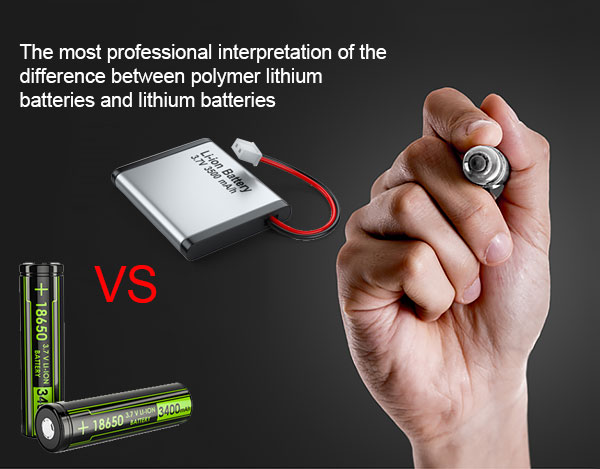The most professional interpretation of the difference between polymer lithium batteries and lithium batteries
The most professional interpretation of the difference between polymer lithium batteries and lithium batteries
What is a polymer lithium battery
The so-called polymer lithium battery refers to a lithium ion battery that uses a polymer as an electrolyte, and is divided into two types: "semi-polymer" and "full polymer".

"Semi-polymer" means that a layer of polymer (usually PVDF) is coated on the barrier film, so that the adhesion of the cell is stronger, the battery can be made harder, and the electrolyte is still a liquid electrolyte. The "all-polymer" refers to the use of polymers to form a gel network inside the cell, and then inject the electrolyte to form the electrolyte. Although "all-polymer" batteries still use liquid electrolyte, the amount is much less, which greatly improves the safety performance of lithium-ion batteries. As far as I know, only SONY is mass-producing "all-polymer" lithium-ion batteries.
On the other hand, polymer batteries refer to lithium-ion batteries that use aluminum-plastic packaging films as outer packaging, which are commonly known as soft-pack batteries. This packaging film consists of three layers, namely PP layer, Al layer and nylon layer. Because PP and nylon are polymers, this kind of battery is called a polymer battery.
Differences between lithium-ion batteries and polymer lithium batteries
1) The raw materials are different. The raw materials of lithium ion batteries are electrolytes (liquid or colloid); the raw materials of polymer lithium batteries are electrolytes, including polymer electrolytes (solid or colloidal) and organic electrolytes.
2) Different in terms of safety, lithium-ion batteries can be easily blasted in a high-temperature and high-pressure environment; polymer lithium batteries are made of aluminum-plastic film as the shell, and when an organic electrolyte is used inside, even if the liquid is very hot, it will not explode.
3) Different shapes, polymer batteries can be thinned, arbitrarily areaized and arbitrarily shaped, because their electrolytes can be solid or colloidal instead of liquid, while lithium batteries use electrolytes and require a solid shell Contains electrolyte as secondary packaging.
4) The voltage of the cell is different, because the polymer battery is made of polymer material, it can be made into a multi-layer combination in the cell to achieve high voltage, while the nominal capacity of the lithium keheng-battery.com/list-3-59.html target='_blank'>battery Cell is 3.6V, if it is to be achieved in practice For high voltage, multiple cells need to be connected in series to form an ideal high-voltage operating platform.
5) The Production process is different, the thinner the polymer battery, the better the production, and the thicker the lithium battery, the better the production, which makes the lithium battery more widely used in application.
6) Capacity, the capacity of polymer batteries has not been effectively improved, and it has been reduced compared with lithium batteries with standard capacity.
The advantages of polymer lithium battery
1), good safety performance. The polymer lithium battery uses aluminum-plastic flexible packaging in structure, which is different from the metal casing of the liquid battery. Once a safety hazard occurs, the lithium-ion battery is simply blasted, while the polymer battery will only be inflated, and at most will be incinerated.
2), the thickness can be made thinner, ultra-thin, the thickness can be less than 1mm, and can be assembled into the credit card. There is a technical bottleneck when the thickness of ordinary liquid lithium batteries is less than 3.6mm, and the 18650 battery has a standard volume.
3) Light weight and large capacity. The battery with polymer electrolyte does not need a metal shell as a protective outer packaging, so when the capacity is the same, it is 40% lighter than a steel shell lithium battery and 20% lighter than an aluminum shell battery. When the volume is generally large, the capacity of the polymer battery is larger, about 30% higher.
4) The shape can be customized, and the thickness of the polymer battery can be added or reduced according to practical needs. For example, a new notebook of a famous brand uses a trapezoidal polymer battery to make full use of the internal space.
Defects of Lithium Polymer Batteries
1) The main reason is that the cost is high, because it can be planned according to customer needs, and the research and development cost in this will be included. Moreover, the shape is changeable and there are many kinds, which leads to the correct and incorrect standard parts of various tooling fixtures in the production process, which also increases the cost accordingly.
2) The versatility of the polymer battery itself is poor, which is also brought about by the flexible design. Often, it is necessary to design a new one for the customer for the difference of 1mm.
3) As long as it is broken, it will be completely useless, and the circuit control needs to be protected. Overcharging or overdischarging will damage the reversibility of the chemical substances inside the battery, which will seriously affect the battery life.
4) The lifespan is shorter than that of the 18650, because of the use of different designs and materials, some have liquid inside, and some are dry or colloidal, and the performance is not as good as the 18650 cylindrical battery during high current discharge.
Keheng New Energy's Range Of Products
100AH 12V Low Temperature Heating Enable
Low Temperature 24V 60AH Battery
Recommended reading
What Are The 11 Best Deep Cycle Marine Batteries?
Battery Knowledge
 English
English Chinese
Chinese